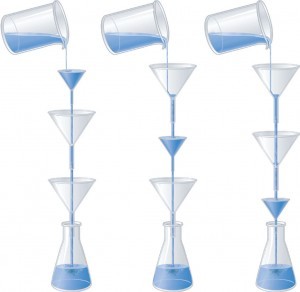Did you ever take chemistry in school? If so, you may remember something known as the rate limiting step. What this means is that when there's a chemical reaction the speed of the reaction may be limited by a particular element. Increasing the concentration of this element allows the entire reaction to happen more quickly. [caption id="attachment_5569" align="aligncenter" width="300"] With the 3 pours, the first funnel will be limited, followed by the middle series and then the 3rd series of funnel. The flow rate in each is limited by the smallest funnel. It's important to know the rate limiting or determining step because then we know where our efforts will generate a better result. Let's look a different example to see how this works. Imagine a busy restaurant that measures each day's success by the number of tables turned over. There will be a maitre-d, a hostess, a server, sous-chefs, head-chefs, bussers and dishwashers. If the dishwasher doesn't show up for work eventually the plates pile up and there will no clean plates to set a new table. Everything backs up at this point. And it doesn't matter if everyone else does a little bit more because the dishes are still piling up, not getting washed and tables are not getting turned over. We can know appreciate that when we're looking to achieve a goal there may be something that limits the outcome. With sprinting for example, we know there are contributions from the lower body joints i.e. the ankle, knee and hip. When walking there is a contribution from each of these joints. As we progress from walking to sprinting is the increased role of these joints proportional? Or are certain joints prioritized? A recent study looked to answer this question. Researchers looked at the involvement of the ankle, knee...
